Am flying off to New Zealand this evening, so doesn't have much time to blog actually :P
Just a few pictures and some basic notes to record some of the things we saw.
We departed from Pasir Panjang Ferry Terminal instead of West Coast Pier today. Helen found a container with some red seaweed and some anemone inside in the female toilet. The male toilet was quite bare though. Still, the poor anemone probably won't be able to survive long... sigh...
Here a group shot of my group just before we entre the forest. They are from IDA and our group name is Sea Stars.
Even before we enter the sea grass lagoon, we found this scallop (Family Pectinidae).
Scallops are filter feeders - they open their shells slightly during high tide to suck in water and collect edible particles. At low tide, they will shut their shells tightly. Scallops can also "swim" by flapping their valves.
We also saw a pair of common sea stars (Archaster typicus), getting ready to perform external fertilisation.
During high tide, the male (on top) and the female (bottom) will release sperm and eggs together. These sea stars can actually burrow into the sand! As a sea star uses sea water to support its body and move its little tube feet. Thus, never take them out of seawater for too long, as it is very stressful for them.
And here's the traditional shot of the group crossing the sea grass lagoon...
As we stepped onto dry land again, we have this sandfish sea cucumber (Holothuria scraba) waiting for us.
This sea cucumber is edible, but must be properly treated before consumption.
On a rock in the coral rubble, we found a cute little onchidium sea slug (Onchidium sp.)! Can you find it in the photo below?
And of course, there was no lack of the master of camouflage - the hariy crab (Family Pilumnidae)!
It can be quite difficult to spot them sometimes since they blend in very well with the rocks.
We saw several pretty fanworms (Family Sabellidae), and here's one of the orange ones we found.
These worms live in flexible tubes. The feathery fan, which is stuck on the worm's head, is used to filter edible particles in the water so that the worm can feed on them.
We found a lovely sunflower mushroom coral (Heliofungia actiniformis) in one of the tidal pools too.
They usually come in brown, but this one was in a lovely shade of green, probably due to the colour of the symbiotic alge (aka zooxanthallae) which lived in it. The algae can actually provide the coral with food from photosynthesis.
There were lots of other hard corals (below top 2), soft corals (below bottom left), and sea anemones (below bottom right) too.
And we also saw several sponges. Here's a Neptune's cup sponge.
And the highlights of the day were usually these knobbly sea stars (Protoreaster nodosus).
And here's the traditional group shot taken with the knobbly sea stars.
We also saw some egg capsules. These were probably squid eggs.
We also saw a few nudibranchs. The name nudibranch actually means "naked gills". Below is a polka dot nudibranch (Jorunna funebris).
Most nudibranchs can secrete chemicals that make them very distasteful or even toxic, while others harbour stinging cells from the animals they feed on.
The nudibranch below is a pustulose phyllid nudibranch (Pyhllidiella pustulosa), which is said to be able to secrete toxins when they are stressed.
The one below is not a nudibranch though, but a sacoglossan, or what we call a sap-suckling slug. This is probably a Thuridilla gracilis.
They normally feed on algae by biting a hole on the latter and suck the cell sap out of it.
We saw a flatworm (Class Turbellaria) too!
Flatworms are so flat that they can easily crawl into tiny cracks on the rocks to hide from predators and also to find preys.
And here's a noble volute (Cymbiola nobilis).
These huge snail normally feed on clams and other shells.
And there were also two cute upside-down jellyfish (Cassiopea sp.).
This jellyfish has symbiotic algae, mostly in its tentacles, which photosynthesises better with it being upside-down. Some of the food made by the algae will leak and get absorbed by the jellyfish.
And on our way back, I saw a trail and scooping under the sand, I found a moon snail (Family Naticidae). It has a really smooth and pretty shell.
I found a heart cockle too!
Well, on the whole, we had a great trip today. Thanks to all the enthusiastic visitors!
Saturday, April 21, 2007
Semakau Walk on 21 April 2007
Thursday, April 19, 2007
Emerged from the Mud Untainted
There is a Chinese saying - 出污泥而不染.
Basically, it is used to describe the lotus, which often grows in muddy water, but emerges untainted by the mud. Sometimes, this is also used to describe someone who grew up in a very bad environment, but yet remains a good person.
I was on a bus along Ang Mo Kio Ave 6 when I saw this lotus pond in Ang Mo Kio Town Garden. It was a truly beautiful sight. I couldn't resist the urge to get down the bus to take a closer look at it.
When did they plant all these? I have never noticed the lotuses before.
The lotus (Nelumbo nucifera) is a spectacular water plant that is commonly found in the tropics. Unlike the other water lilies, which have their leaves floating on the water surface, the leaves of the lotus are usually held above the water.
Personally, I also find the flower of the lotus to be the most spectacular among all the water lilies.
The flower starts off as a little flower bud.
Then one morning, the tips of the petals will slowly open.
Soon, the female reproductive structure and the tips of the stamens will be exposed, and they will start producing a strong perfume.
This will attract its potential pollinators - the insects, which may fertilise one or more ovules if they have previously visited other lotus flowers.
As night falls, the flower closes up, thus trapping any late pollinators in it. Pollen is shed within the flower to provide a reward to the pollinators wandering around the flower. It is possible that self-fertilisation may occur then.
The next morning, the flower will open into a bowl shape.
The overnight visitors will be free to leave, covered in pollen from this flower, ready to fertilise the ovules of other flowers they are visiting.
That night, the flower closes more loosely and traps potential pollinators again. The petals will also start to wither.
On the morning of the third day, the flower will open fully.
The petals and stamens will be shed over the following day or within a few days. Eventually, the fruit in the middle will be revealed.
And soon, only the green fruit is left.
The fertilised ovules will slowly develop into seeds, and the fruit grows bigger.
Finally, the seeds are mature and ready to be shed.
It is said that the seeds are very long-lived, and some seeds actually managed to germinate hundreds of years after they were formed! In fact, the oldest seed that has germinated into a viable plant was from an approximately 1,300-year-old lotus fruit, recovered from a dry lake bed in northeastern China!
Isn't that ULTRA AMAZING???
The lotus is also a very useful plant. The flowers, seeds, young leaves and rhizomes are edible. When dried, the stamens can also be made into a herbal tea, and the petals can be used for garnishing. The large leaves are used as a wrap for food.
The lotus is also the national flower of India, and is often seen as a sacred flower by the Hindus, Buddhists and Baha'i. In fact, when I went to India about two years ago, I saw this Baha'i Temple that was built to look just like a lotus!
The lotus pond attracted a number of insects, and I saw many dragonflies (Suborder Epiprocta) and a few damselflies (Suborder Zygoptera).
Here's a beautiful dragonfly, black with yellow stripes (or is it yellow with black stripes? Hmmmmm...)
During my kampong days, we used to call this 红阿姨, which basically means red auntie.
And here's a really pretty one in blue.
The one below is a damselfly though, not a dragonfly.
Damselflies are quite similar to dragonflies. To tell the difference, look at the the wings. Most damselflies held their wings along the body when they are at rest. They are also smaller and weaker fliers compared with dragonflies.
A beautiful lotus pond with lots of dragonflies and damselflies - that certainly made my day! I'll definitely return to this place again :)
Wednesday, April 18, 2007
Clear Water at Sisters
The water was ultra clear when we went to Sisters Island last Sunday. There was another gang of 15-20 odd people on the island as well. Probably anglers, I guess.
Didn't have much time to explore as I had to assist Alvin, but that didn't stop me from snapping a few shots of the interesting stuff I saw along the way :)
Here's Alvin with his latest invention.
Heh heh, can't remember what's the name they give it. But anyway, it's a plastic box with a hole in front (ok ok, and another on top of course, I know I know) which Alvin covered with a piece of clear plastic. Anyway, he made it such that the thing was kind of waterproof, so that he could place the video camera inside and shoot through the hole... or rather, through the piece of acrylic covering the hole.
And here's the wild thing he was shooting, a yellow-lipped sea krait (Laticauda colubrina)!
These pretty snakes are highly venomous, but don't usually attack humans. I had several encounters with them on Sisters Island actually.
And here's a mole mushroom coral (Polyphyllia talpina).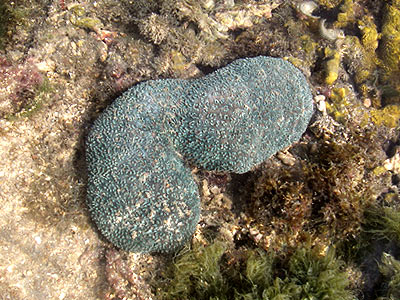
This coral is a free-living colony! It is also listed as one of the threatened animals in Singapore.
As the water was so clear, all the other corals also looked exceptionally beautiful! Here are some of the hard corals I saw that day.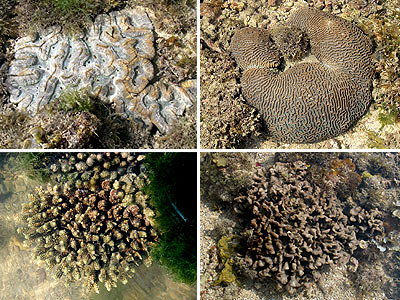
There were splashes of Halymenia red seaweeds (Halymenia sp.) here and there as well, and they looked really pretty underwater.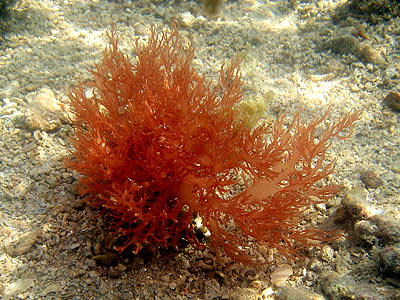
Some Halymenia species are eaten by people, but I'm not sure about this one though :P
But the highlight of the day must be this ultra cute little animal!
What does it looked it to you? Adapting from the line they often used in Superman...
It's a squid! It's a cuttlefish! It's a... slug???
Yes! This is a slug. A slug that swims. It's a sidegill slug (Euselenops luniceps).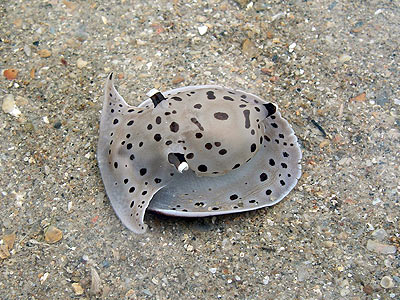
I remembered reading Dr Chua's book sometime back when I saw a picture of this slug, and I was thinking when will I finally get to see this cute little animal.
And finally! I got to see it!
This slug can actually dives under the surface of the sand to feed and hide from predators. Like other slugs, they are also hermaphrodites and each has both male and female reproductive organs.
They are, however, not nudibranchs, but pleurobranchs. According to the Sea Slug Forum, we can differentiate pleurobranchs from nudibranchs by the enrolled head tentacles and the large gill found along the right side of the body. Nudibranchs have very distinctly shaped rhinophores, and the gills, if present, form a circle in the dorsal midline.
And we found three of these slugs last Sunday! What a great day :)
However, on our way back to the jetty, and unsightly sight was waiting for us...
Read the Annotated Budak's blog for for details...
Monday, April 16, 2007
Macro Beauty at Khatib Bongsu
Here comes part 2 of our adventures at Khatib Bongsu.
For the photographers who are into taking macro shots, Khatib Bongsu certainly offers lots of opportunities for really nice close-ups of insects, spiders, other small animals, and also flowers and fruits.
I don't know the ID of most of the animals who became my unwilling models actually, since I'm more familiar with intertidal stuff, being an intertidal guide. Will be grateful if anyone reading this can help :)
One of the first insects we encounter, apart from the mosquitoes, was this cute little cricket below. There was a bit of wind, and I had a lot of problem focusing. This is the only photo which turned out ok :P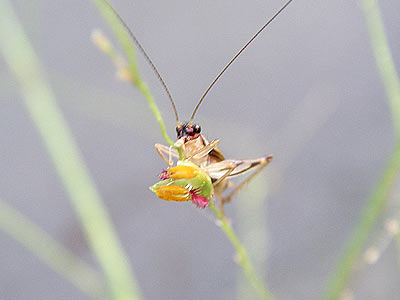
This little ant was busy climbing all over a grass, casting a lovely silhouette. Looking for ripe grains, maybe?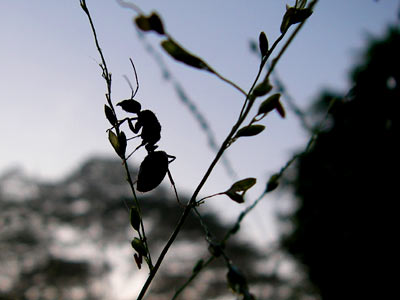
These two bugs were hardly moving when I found them. Not sure about their ID though.
And here's another unidentified insect, blending in perfectly with the surrounding leaves. I could have missed it if it wasn't crawling over the flower of the giant mimosa.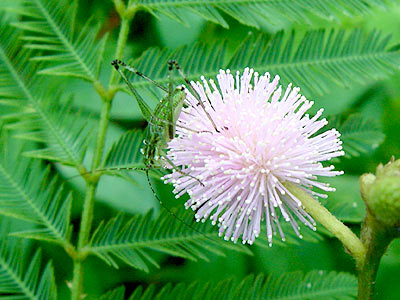
A cotton stainer bug, which was much easier to spot compared with the other insects with its beautiful colours.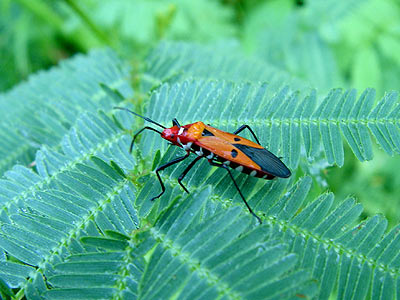
And here's a cute stick insect. It's supposed to be a master of camouflage, but seems like it chose the wrong place to camouflage itself.
Yet another insect which I don't know the name.
And here's a female dragonfly, which is supposed to less colourful compared with the male ones.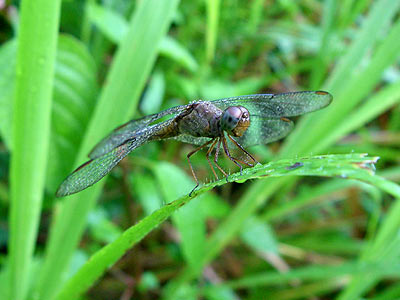
A bee wet from the morning dew. You can see a water droplet dripping off it's butt.
We saw quite a few grasshoppers too. And seeing them jumping among the grasses like they were shopping for the freshest grass, I decided to call them grass shoppers instead :P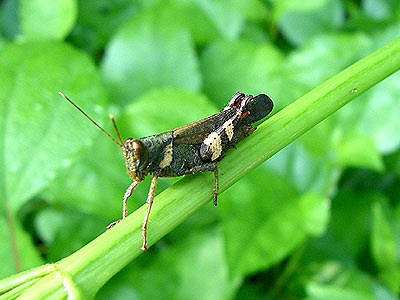
Another "grass shopper".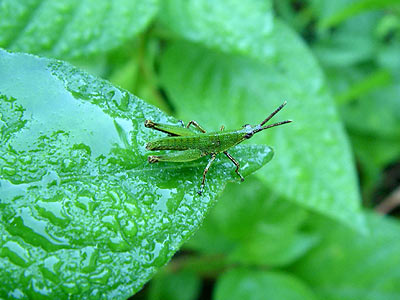
It was also a really sexy day, and we saw a number of insects working hard for their next generation.
And here's another pair doing it.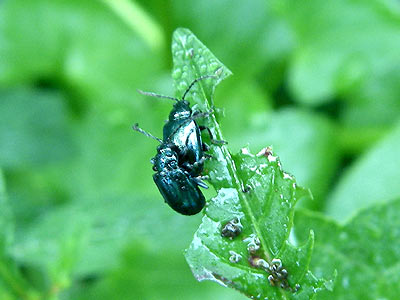
We saw quite a number little spiders too! Here's one beside its web, waiting for any visitors to "drop by".
Here's another one...What long legs it had...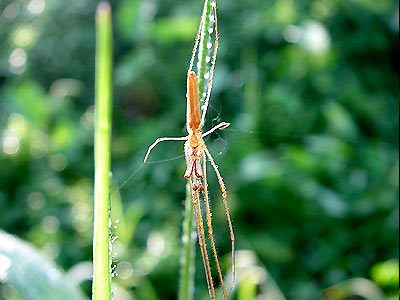
And this spider was even more amazing. At one time, it just straightened up stuck its legs together, and looking just like a twig!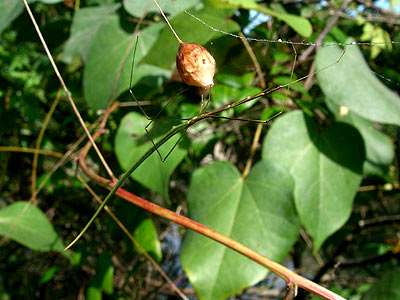
And this is some worm's hidding place.
There were lots of snails too.
This one looked like its shell had gone under its skin...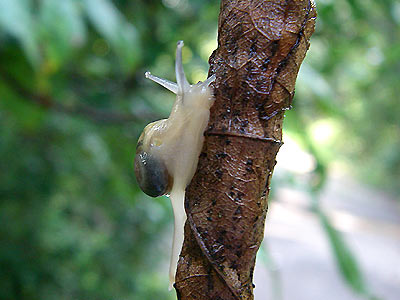
There were lots of plants at Khatib Bongsu too, like this buah cherry tree has lots of lovely little flowers, which look like the cherry blossom in Japan.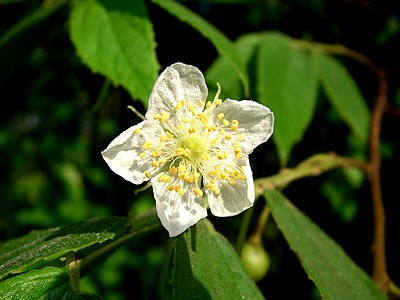
One of the less common morning glory. The flower is about the size of a twenty cent coin only!
And here's an unidentified plant with a tiny flower.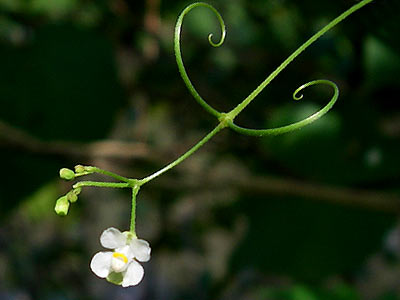
And these are its fruits.
We also found a "love in the mist" creeper, with a few ripe fruits.
And here are 2 really cute little fruits.
All photos above were taken with a simple point-and-shoot digital camera using the macro mode. I'm not a professional photographer actually. So if you are one of those using a digital SLR, do visit Khatib Bongsu while you can, and I'm sure your shots will turn out much better than mine! :)
